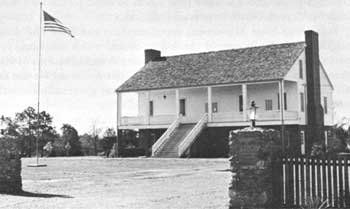





Survey of Historic Sites and Buildings
 |
FORT JESUP Louisiana |
 |
| ||
From its founding in 1822, when it was the most southwesterly outpost of the United States, until its inactivation in 1846, this fort was the southern anchor of the "Permanent Indian Frontier." Because of a dispute over the Texas-United States boundary, in 1806 Spain and the United States had designated as a neutral strip an area 30 to 40 miles wide extending eastward from the Sabine River and embracing most of the present western tier of parishes in Louisiana. Under the Adams-Onis Treaty of 1819, the United States acquired the strip, which had become a haven for outlaws and marauders who molested settlers emigrating to Texas, and moved swiftly to occupy and police it. Pending ratification of the treaty, which occurred in 1821, the U.S. Government in 1820 built Fort Selden, La., on the Bayou Pierre near its junction with the Red River just outside the strip on its eastern edge. The following year it made plans to set up another post nearer the Sabine.
The Army abandoned Fort Selden in 1822. Lt. Col. Zachary Taylor occupied the watershed between the Sabine and the Red Rivers and moved to a point 25 miles south-southwest of Fort Selden, where his troops built a group of log cabins that became Fort Jesup. Within a few months, it had the largest garrison in Louisiana, consisting of a battalion of the 7th Infantry under Lt. Col. James B. Many. In 1827-28 the troops helped construct a military road 262 miles northwest to Fort Towson, Okla. Gen. Henry Leavenworth commanded Fort Jesup in the years 1831-33. The next year Colonel Many reassumed command and garrisoned it with six companies of the 3d Infantry. In 1833 the Government, recognizing the enlargement and expansion of the post, created the 16,000-acre Fort Jesup Military Reservation. The following June troops from Fort Jesup participated in the ceremonies involved in the signing of the Caddo Indian Treaty at the Caddo Indian Agency headquarters, on the bluff overlooking Bayou Pierre, some 9 miles south of present Shreveport. This was the only treaty the U.S. Government ever executed with the Indians in Louisiana.
 |
| Reconstructed officers' quarters and modern visitor center, Fort Jesup State Monument. (Louisiana State Parks and Recreation Commission) |
After the Texas Revolution began in 1835, reinforcements arrived at Fort Jesup. Maj. Gen. Edmund P. Gaines assembled 13 infantry companies at the fort and early in 1836 marched to the Sabine, where he founded the temporary post of Camp Sabine. From there he occupied Nacogdoches and remained until the independence of Texas was assured. In 1846, the year after President James K. Polk ordered Gen. Zachary Taylor, the Fort Jesup commander, to move a force into Texas in anticipation of a war with Mexico, the Army inactivated the fort.
Fort Jesup State Monument commemorates the fort. The only original building is one of the log kitchens, which has been repaired, reroofed, and refurnished with period reproductions of authentic kitchenware. An officers' quarters, reconstructed for use as a visitor center and park administrative office, contains historical exhibits.
NHL Designation: 07/04/61
 |
 |
http://www.cr.nps.gov/history/online_books/soldier-brave/siteb11.htm
Last Updated: 19-Aug-2005